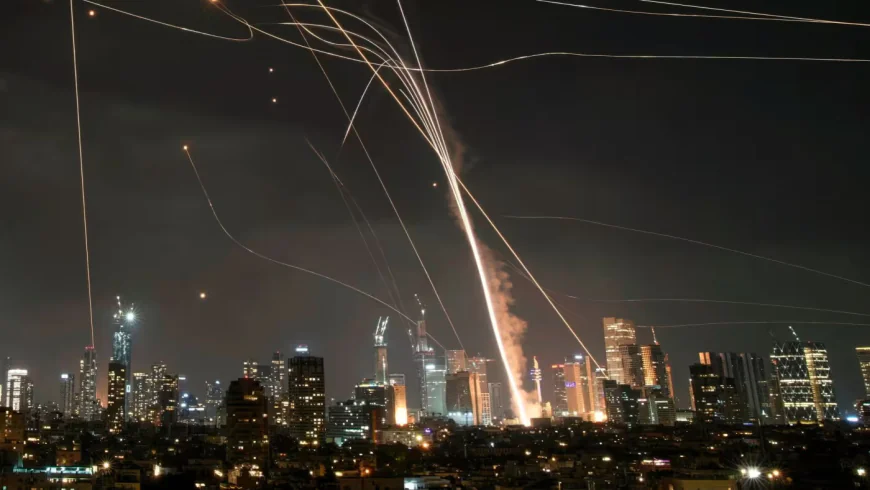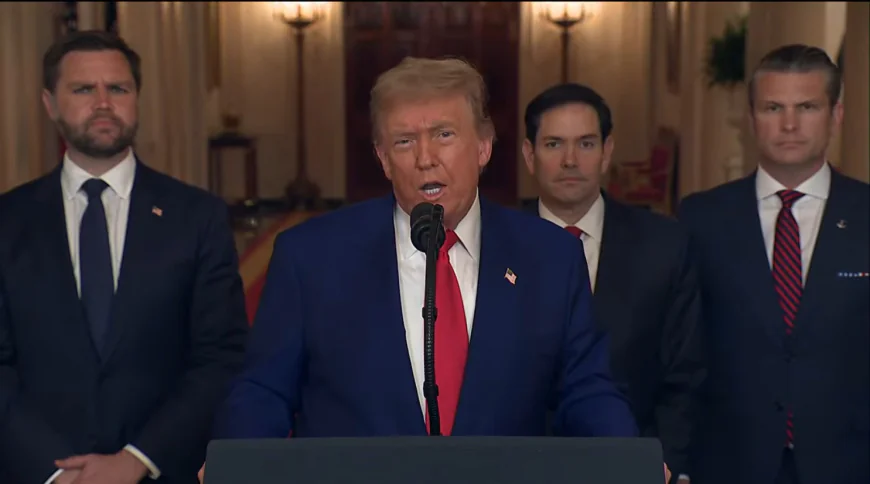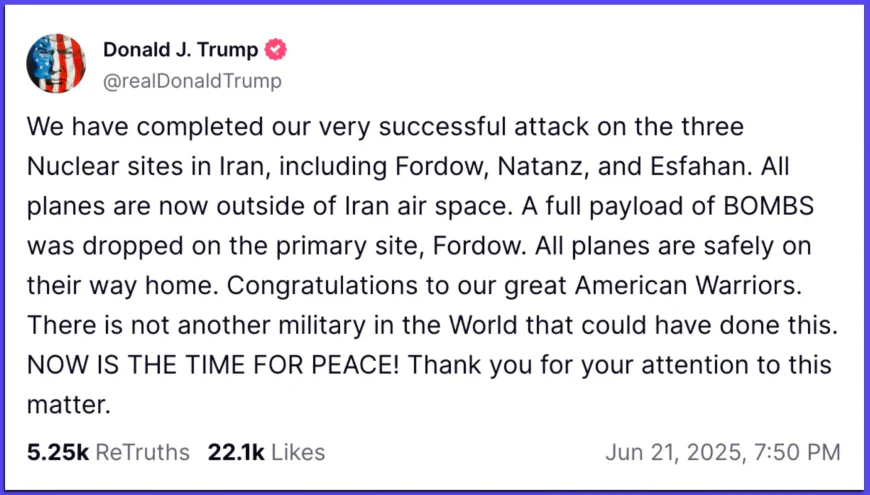The Worst US Foreign Policy Decision in History
Tensions escalate in Israeli-Iranian War after U.S. strikes Fordow nuclear facilities, raising fears of global energy disruption and broadening the conflict to include the United States.

The Worst US Foreign Policy Decision in History
Daryl Barenziah
06/22/2025

Image taken from FOX broadcast on President Trump addressing the nation and world after U.S. strikes on the Fordow underground nuclear facility in Iran.
Tensions escalate in Israeli-Iranian War after U.S. strikes Fordow nuclear facilities, raising fears of global energy disruption and broadening the conflict to include the United States.
As the scorched earth at Iran’s Fordow nuclear site continues to smolder in the twilight hours following a high-profile U.S. strike, questions remain unanswered—not least of which is what Washington hoped to achieve beyond satisfying internal political divides and managing hawkish pressures within the corridors of former President Donald Trump’s administration. The military campaign, ominously codenamed Midnight Hammer, was swiftly followed by a flurry of posts on Trump’s social media platform, Truth Social, where the former president framed the strikes as strategic and “measured,” claiming they were in pursuit of stability and peace in the region.
However, behind the scenes, Tehran’s upper leadership was already signaling serious repercussions. According to a June 19, 2025 report by Reuters, senior Iranian officials—including members of the parliamentary National Security Committee—stated that closing the Strait of Hormuz was “one of the potential options” under consideration should the United States escalate military action against Iran. (Reuters, 2025) A narrow but crucial maritime chokepoint. If confirmed, such a move could ignite a global energy crisis and further entrench divisions in an already volatile geopolitical landscape.
The global significance of the Strait of Hormuz cannot be overstated. Roughly 20 million barrels of oil per day—or about 20 percent of the world’s daily petroleum consumption—pass through this narrow passage linking the Persian Gulf to the Arabian Sea. In the wake of the Fordow strike, global markets braced for the worst. Oil prices surged to five-month highs, with Brent crude climbing above $93 per barrel, reflecting mounting fears of a wider regional confrontation. Analysts warned that even the threat of closure could send prices soaring past $100 per barrel, triggering ripple effects across global inflation and energy supply chains. As Business Insider reported on June 20, 2025, these market jitters stem directly from the Strait’s vulnerability, with no viable alternative capable of handling the volume of traffic it carries daily. (Business Insider, 2025)
While the precision strikes on Iran’s nuclear infrastructure may seem like the handiwork of the newly re-elected Trump administration, their origins actually trace back to strategic planning initiated under President Biden. According to a January 2, 2025 report by Axios, President Biden and his National Security Advisor Jake Sullivan had already extensively “discussed potential U.S. military action against Iran’s nuclear facilities”—arranging contingency strike options should Tehran accelerate its weapons ambitions prior to the 2025 inauguration. (Axios, 2025) This forethought blurred partisan lines on Iran policy, making the operation less a spontaneous act and more a culmination of months-long national security planning.
Given this backdrop, it comes as no surprise that Vice President Kamala Harris has repeatedly labeled the “Iranian regime” as the United States’ foremost adversary in global foreign policy. Her remarks—when taken alongside Biden’s strike-architecture planning—frame these military actions not as partisan gestures, but as part of a broader, bipartisan U.S. strategy aimed at curbing Iran’s nuclear advancements.
In a March 2024 interview with CBS News, Vice President Harris stated unequivocally, “We will not allow Iran to become a nuclear power. Period.” Her tone was firm, her language devoid of the diplomatic hedging so often associated with multilateral negotiations. In another appearance on Face the Nation, she referred to the Iranian leadership as “a destabilizing force across the Middle East” and affirmed that “every option is on the table” when it comes to U.S. national security. These declarations, now echoed in action, cement her position within a continuum of American officials—regardless of party—who view Iran not only as a challenge, but as a cornerstone of their foreign policy posture.
U.S. leadership has long harbored a readiness to confront Iran militarily—a stance nurtured by conservative institutions over generations. The Heritage Foundation, founded in 1973, has infused U.S. foreign policy with sustained ideological firepower, particularly through its flagship policy roadmaps like Mandate for Leadership and its advocacy of the Reagan Doctrine, which explicitly listed Iran as a regime-driving regime-change target in the 1980s. Its scholars have consistently portrayed Tehran as a central threat—urging policymakers to pursue containment, sanctions, and, if necessary, military options.
This longstanding policy continuity finds deep roots within congressional halls, where AIPAC’s well-documented influence cements the mantra of Iran hawkishness as bipartisan orthodoxy. On the right, figures like Lindsey Graham and Ted Cruz echo this aggressive posture; on the center-left, voices from Kamala Harris to Hillary Clinton to Senate Majority Leader Chuck Schumer have all signaled that confrontation with Iran remains Washington’s default foreign policy lane .
But what this is all to say is that, in the aftermath of the attacks, one is compelled to ask—not just why, but to what end? The bombs may have fallen in Iran, but the ideological conditions that justified them were manufactured long before the smoke ever rose. I underscore these domestic relationships—not out of abstraction, but because they form the crenellations of the great castle that is U.S. defense policy. These aren’t incidental details; they are the battlements from which war is waged, shaped in think tanks, lobbied through foreign influence, and echoed in the polished tones of press conferences.
The Democratic Party, for all its gestures toward social liberalism and civil decorum at home, remains firmly tethered to the same foreign policy project as the Republicans: a muscular, imperial vision of American dominance abroad. It manifests differently—more technocratic under Democrats, more apocalyptic under Republicans—but the substance remains unchanged. Call it continuity, call it consensus, or call it empire in bipartisan clothing. Whatever name you give it, the effect is the same: two wings of the same war machine. And in that sense, the parties are not rivals—they are uniformed in the same army.
Now, we must address the nature of the targets themselves. These were civilian nuclear facilities—not underground missile silos, not fortified military compounds. Sites like Fordow and Natanz have, at various intervals, operated under the supervision of international nuclear monitoring bodies, including the International Atomic Energy Agency (IAEA). These facilities were part of negotiated frameworks with multinational scientific oversight, including participation or inspection from countries such as Russia, China, Germany, and France, among others. The strike, therefore, was not just provocative—it was illegal, standing in direct violation of both international law and longstanding non-proliferation agreements. As for its legality under domestic U.S. policy, we’ll set that aside—not for lack of importance, but because the American legal framework for war powers and oversight has been methodically dismantled since the onset of the Global War on Terror.
Amidst mounting criticism, the responsibility of the U.S. and its allies to adhere to international law has been notably absent. On June 22, 2025, the United Nations and a host of global leaders—including the UAE, Qatar, and Japan—rejected the strikes as a blatant violation of the UN Charter and international law, urging an immediate shift toward diplomacy (Reuters, 2025). Their collective voices underscore a long-standing pattern: Washington and its partners have routinely sidelined UN mandates, preferring unilateral military interventions under the banner of national security or preemptive defense.
And yet, even on tactical terms, the strike appears to have accomplished little. Satellite imagery and early reports from the site show limited structural damage, no significant secondary detonations, and—crucially—no signs of nuclear contamination. This leads us to two sobering questions. First: Was the risk of nuclear fallout in Central Asia simply not considered by U.S. military planners? What would a Chernobyl-scale radiological disaster have looked like in this geopolitically volatile region? The recklessness is staggering. And second: If these facilities were indeed manufacturing nuclear weapons, wouldn’t we expect fallout?

Satellite image by Maxar Technologies shows the Fordow underground nuclear facility in Iran before U.S. strikes.
SATELLITE IMAGE ©2025 MAXAR TECHNOLOGIES

Satellite image by Maxar Technologies shows the Fordow underground nuclear facility in Iran after U.S. strikes taken on June 22, 2025.
SATELLITE IMAGE ©2025 MAXAR TECHNOLOGIES
The logical conclusion, and my educated supposition, is that ample time was permitted to Iranian authorities to move or shield any sensitive materials, given that public hints of an impending strike had been circulating since April 2025. The origin of that leak? None other than U.S. Secretary of Defense Pete Hegseth, whose operational security gaffes inadvertently tipped Iran to prepare for what was coming. A war strike broadcast in advance is not a show of strength—it’s theater. And in this act, the audience was warned.
The whole ordeal reeks—whether of pure incompetence or strategic theater remains uncertain. I lean toward a synthesis of both, contingent on how much of each ingredient was in play. There are two overlapping possibilities, each grim in its own right. First, we must consider the undeniable influence of Israel on U.S. foreign decision-making, especially when it comes to Iran. Whether through direct intelligence coordination, lobbying networks, or military pressure, this strike may well be part of a long-standing Israeli strategy: baiting Iran into retaliatory action that would inescapably pull the United States deeper into regional war. In that scenario, an Iranian counterattack on American forces or assets becomes the red line that justifies total war—a fulfillment of Israeli foreign policy.
Israel’s push to draw the United States into open conflict with Iran is no recent development—it’s the product of decades of strategic ambition. From lobbying efforts to military coordination, the goal has long been to secure American military backing against Tehran. As Reuters recently reported, Israel had “planned Iran strikes with or without U.S. support,” but actively pressed for American involvement to ensure a broader confrontation would unfold on their terms (Reuters, 2025).
The second possibility is more domestic, but no less concerning. Elements within the Trump administration, including factions not necessarily aligned with the president’s own instincts, may have successfully leveraged bureaucratic inertia, military planning channels, and deep state actors to force the strike forward. The confused messaging from both Trump and Vice President J.D. Vance following the attacks—where they simultaneously invoked “peace” while defending the operation—suggests either a deliberate sleight of hand or that they themselves were outmaneuvered by their own administration. The notion that anyone in power believed a “shock-and-awe” campaign could clear the way for diplomatic solutions is either stunningly naïve or intentionally disingenuous. Either way, it presents a performative contradiction: a White House that calls for peace while lighting the match in a powder room.

Screenshot from Truth Social, posted by President Trump, Jun 21, 2025.
Either way, what we are witnessing may well go down as one of the greatest foreign policy blunders in U.S. history (Colonial Outcasts, 2025). The United States—the most powerful military force on Earth—has now been pulled directly into the tit-for-tat missile exchanges between Israel and Iran that have escalated over recent weeks. This is not strategic diplomacy. This is a slow-motion catastrophe, unfolding in real time. Whether these strikes manage to dismantle Iran’s nuclear ambitions or merely deepen the spiral of regional conflict in the Middle East remains to be seen. But what I can say with absolute certainty—as a U.S. citizen with a close pulse on the political terrain of this country—is that this moment marks a failure. Not necessarily for the Pentagon, nor for the electorate, but for whatever factions within the American power structure successfully pushed this through. A failure in delivery. A failure in timing. And, above all, a failure in vision.
By and large, what must also be said—without hesitation—is that U.S. foreign policy is deeply ideological. It does not move solely from strategy, necessity, or threat, but from a kind of idealism, a belief in the righteousness of American power. Yet idealism rarely triumphs over material conditions, especially when those conditions are shaped by sovereign states determined not to be subjugated. The Iranian military, for instance, is ranked as the 16th most powerful in the world, with extensive experience in unconventional warfare, regional proxy networks, and battlefield adaptability (Global Firepower, 2025).
What’s more, even within U.S. military simulations, there is evidence that the Islamic Republic could successfully outmaneuver American forces in a direct confrontation. One such simulation—Operation Millennium Challenge, conducted in 2002—showed how a highly mobile, decentralized, and non-conventional opponent could inflict severe losses and strategic confusion on the U.S. military, effectively halting a campaign before it could be completed. A simulated “Red Force” modeled on Iranian tactics could outmaneuver and cripple U.S. operations using unconventional strategies, swarms of small boats, and missile barrages (War on the Rocks, 2015).
This was not a fluke—it was a warning. And if regime change in Iran is truly the end goal of these escalations, then one has to ask the most sobering question of all: What regime has ever been changed without boots on the ground? Airstrikes may shatter infrastructure, but occupation is the price of transformation. And the United States, already weary from two decades of war, may soon find itself materially and morally bankrupt in its pursuit of yet another idealized crusade.
Most of me believes that what we are witnessing is an attempt by the United States—aligned closely with Israel—to recreate the conditions that led to the fall of Libya and the execution of Muammar Gaddafi. The blueprint is familiar: isolate the regime, provoke overreaction, justify intervention, and leave a country in ruin. The difference here is that Iran is not Libya, and the Islamic Republic is not without its own strategic providence, regional alliances, and deep historical roots. Where Gaddafi stood alone, Tehran is backed by asymmetrical strength and potential alliances with nuclear-armed states, making any comparison dangerous at best—and catastrophic at worst.
Part of me wonders if the world—especially those in the Global South—should stop looking to the integrity of U.S. foreign policy as any benchmark for lawful conduct. After all, America’s track record with international law is marked more by selective enforcement than principled consistency. Perhaps, instead, vulnerable nations should begin to seek security through alignment with multipolar powers, rather than hoping the West will respect their sovereignty when the time comes.
At the helm of this slow-motion disaster are what appear, increasingly, to be fumbling fools in Washington. And even if Trump himself is not fully lost, his age and isolation seem to have left him vulnerable to the more militant voices inside his administration, who may be steering this policy ship toward wreckage. Still, for all our geopolitical critique, I return to the human cost. Whatever continues in the region—whatever vengeance or strategy is yet to unfold—I offer only this: a prayer for the people of Iran, Israel, and Palestine, that peace comes swiftly, and that mercy falls equally upon combatants and civilians alike.
In the end, we are left with more questions than certainty, and more consequence than strategy. The United States, in alignment with Israel, has made its move—a gesture soaked in history, ideology, and miscalculation. Whether this gambit succeeds in altering Iran’s trajectory or merely plunges the region into deeper war, it has already revealed the moral and strategic bankruptcy of U.S. foreign policy in the Middle East. The echoes of Libya, Iraq, and Afghanistan are not distant—they are immediate, loud, and unlearned.
The fantasy of clean intervention, of surgical strikes leading to democratic rebirth, is as dangerous now as it was in 2003. But Iran is not a fractured state propped up by U.N. observers and oil contracts. It is a sovereign nation with regional power, global alliances, and a population that has endured every form of siege. And while American policymakers may still believe in the illusion of dominance, power is no substitute for wisdom, nor is ideology a shield against reality.
If peace is still possible—and I believe it is—it will not be delivered by drones or declarations. It must come through de-escalation, diplomacy, and a fundamental reckoning with the imperial reflex that has guided both Democratic and Republican administrations alike. Until then, I stand not with the war drums of Washington, but with the innocents in Tehran, Tel Aviv, and Rafah, whose lives hang in the balance of decisions made far from home.
May wisdom prevail where violence has failed. May the region find its breath before it is suffocated by another American crusade. And may the world remember that the powerful are not always right, and the weak are not always without recourse.


